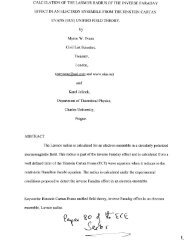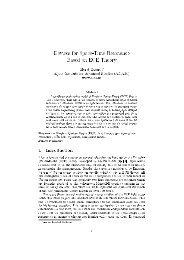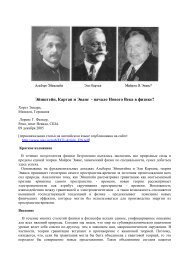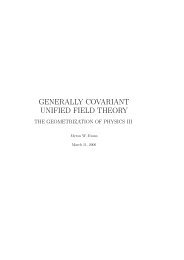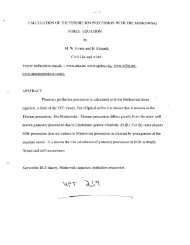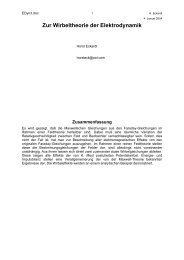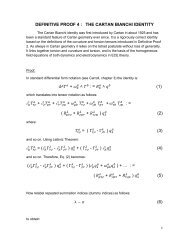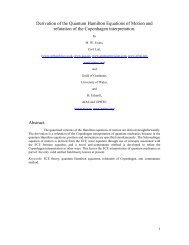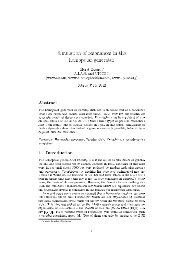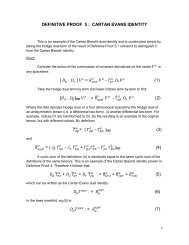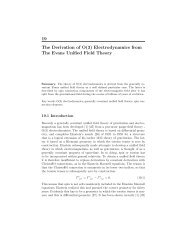Einstein, Cartan and Evans – Start of a New Age in Physics? - Aias.us
Einstein, Cartan and Evans – Start of a New Age in Physics? - Aias.us
Einstein, Cartan and Evans – Start of a New Age in Physics? - Aias.us
Create successful ePaper yourself
Turn your PDF publications into a flip-book with our unique Google optimized e-Paper software.
ECE Theory, H. Eckardt, L. Felker 09. Dec. 2005<br />
5 Implications for quantum physics<br />
The ma<strong>in</strong> implication is that quantum theory <strong>in</strong> its current form is not a fundamental<br />
description <strong>of</strong> Nature. In particular, the Heisenberg <strong>in</strong>terpretation <strong>and</strong> the Correspondence<br />
pr<strong>in</strong>ciple are <strong>in</strong>correct. The ECE version <strong>of</strong> quantum physics rests upon a classical, fully<br />
determ<strong>in</strong>istic basis; quantum <strong>in</strong>determ<strong>in</strong>acy plays no role. Nevertheless the equations <strong>of</strong><br />
quantum mechanics (for <strong>in</strong>stance the Schroed<strong>in</strong>ger equation) are correct <strong>and</strong> describe<br />
classical statistical processes. It would be a mark aga<strong>in</strong>st ECE theory if it did not predict this<br />
result, beca<strong>us</strong>e the equations <strong>of</strong> quantum mechanics are experimentally verified a tho<strong>us</strong><strong>and</strong>fold.<br />
<strong>Evans</strong> also argues that the Heisenberg Uncerta<strong>in</strong>ty relation arose only by a<br />
misunderst<strong>and</strong><strong>in</strong>g, <strong>and</strong> is not j<strong>us</strong>tifiable. All physical mass-po<strong>in</strong>ts <strong>of</strong> a field theory are actually<br />
densities -- i.e. quanta <strong>of</strong> matter-energy spread over a volume <strong>of</strong> space. Thereby the Planck<br />
quantum <strong>of</strong> action is to be divided by the volume, for <strong>in</strong>stance, <strong>of</strong> the measur<strong>in</strong>g <strong>in</strong>strument <strong>in</strong><br />
which two complementary variables (e.g. position <strong>and</strong> momentum) are measured. The result<br />
can become arbitrarily small, i.e. the uncerta<strong>in</strong>ty can be reduced to powers <strong>of</strong> ten smaller<br />
than previo<strong>us</strong>ly believed. An elementary particle, therefore, is neither excl<strong>us</strong>ively a wave, nor<br />
excl<strong>us</strong>ively a particle, but possesses characteristics <strong>of</strong> both at the same time.<br />
This sounds fantastic as a theory <strong>of</strong> physics, but exactly that was measured already some<br />
years ago [5]. The experimental refutation <strong>of</strong> the uncerta<strong>in</strong>ty relation was accomplished by<br />
ma<strong>in</strong>stream physics.<br />
Electron paths<br />
Solenoid<br />
Electron<br />
source<br />
Double<br />
Holes<br />
Screen<br />
Fig.3: The Aharonov Bohm effect<br />
As a further example <strong>of</strong> an effect which was previo<strong>us</strong>ly difficult to expla<strong>in</strong>, we consider the<br />
Aharonov Bohm effect (Fig. 3). Two electron beams are diffracted by a double gap, at the<br />
screen, a typical <strong>in</strong>terference pattern is produced. In the diffraction zone is a closed toroidal<br />
coil. The magnetic field is circularly closed <strong>and</strong> th<strong>us</strong> rema<strong>in</strong>s with<strong>in</strong> the coil. If one now<br />
switches on <strong>and</strong> <strong>of</strong>f the magnetic field, <strong>in</strong> each case two different <strong>in</strong>terference patterns result.<br />
The closed magnetic field th<strong>us</strong> has an effect on the electron beams, although these are not<br />
<strong>in</strong> direct contact with the coil. This appears to be a quantum-mechanical “action at a<br />
distance“, which has given rise to many conf<strong>us</strong>ions <strong>and</strong> unsound speculations.<br />
This problem is treated <strong>in</strong> ECE theory as follows. The magnetic field <strong>of</strong> the coil creates a<br />
space-time “vortex” (due to its torsion) which extends <strong>in</strong>to the space outside <strong>of</strong> the coil itself.<br />
The pull<strong>in</strong>g effect <strong>of</strong> this vortex (i.e. the effect <strong>of</strong> vector-potential A) is then able to <strong>in</strong>fluence



